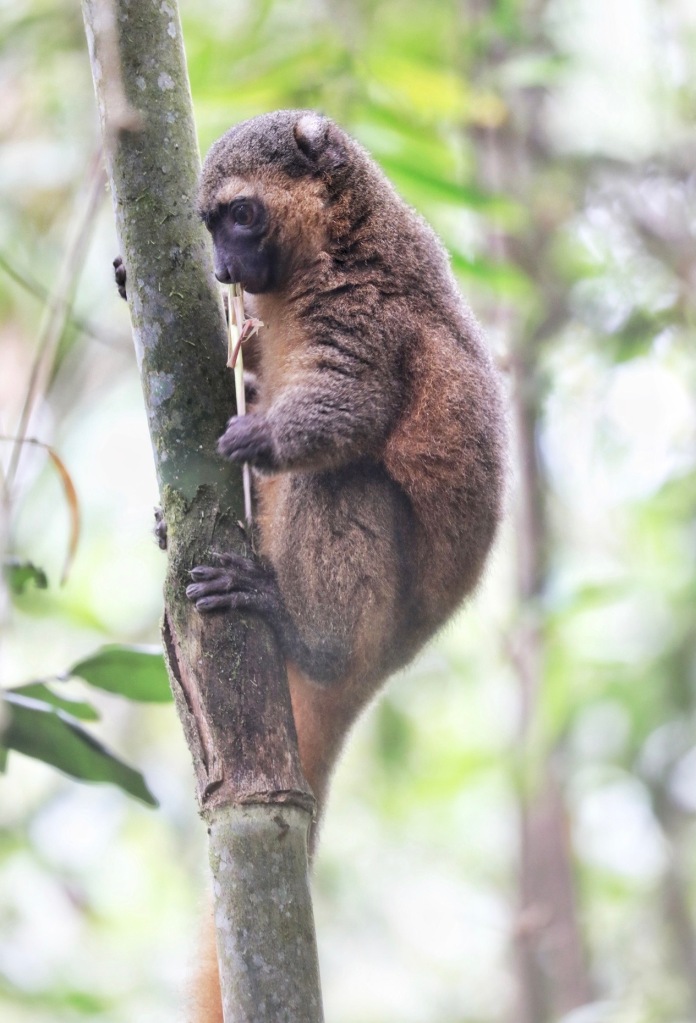
Madagascar is home to 6 of the 8 existing species of Baobab in the world. Here in the Avenue of Baobabs, near Morondava, Madagascar, individuals of three Baobab species are the remnants of the dry, deciduous native forest that has been replaced by agricultural fields.
Baobab are often called bottle trees, or upside-down trees, for their strange, thick cylindrical shapes that taper at the crown before branching into what resembles a mass of roots that are actually its branches.

A lone Baobab tree still standing in a Malagasy farm yard.
Not only is their structure unique and remarkable, but their annual phenology (cycle of leaf, flower, fruit production) is as well. The trees shown here flower during the dry season from May to August, but each flower lasts less than a day, and the entire flower production of the tree may last less than a week. Leaf production follows during the wet season from October to May, which marks the period of tree growth and fruit production.

Flowers burst into full display from buds within a few hours, displaying creamy white petals below a huge mass of anthers (yellow-tipped filaments in the image). All the pollen is released the first night the flower is open. The floral perfume and nectar attract huge numbers of pollinator visitors: hawk moths, fruit bats, birds, and mouse lemurs.

The fruits are dry, but full of vitamins (C and B6) and sugars. They are protected by a thick shell, but some baobab species drop the fruit from the husk at ripening, making them available to birds and mammals on the ground.
Baobab also provide roost and nest sites for a variety of animals: the dense array of their branches are ideal platforms for nesting birds, for example, and we did see a few species cruising the tree’s upper architecture, perhaps looking for the perfect spot.

A Sickle-billed Vanga poked around a bit, maybe hunting for insects, or a nest site?

Sakalava weavers flitted through the low bushes and over the tops of the Baobab. Weavers build remarkably complex nests in trees, but I don’t know if Baobab is one of their preferred nest sites.
But the most intriguing thing about these unusual trees is why they look like they do! Is the shape really an adaptation to life in an arid landscape, with the trunk acting like a water reservoir in times of drought? Do the trees use the water in the trunk for photosynthesis to build flowers, leaves and new branches?

The trunk diameters are impressively large, more than 9 feet in this tree (according to the 6 foot person standing next to the base). And the trunk supports a massive weight of tree that may reach 100 feet or more in height. Baobab grow very, very slowly. The giant is probably hundreds if not thousands of years old, while the young sapling may already be dozens of years old.
Researchers from the Missouri Botanical Garden and the Kirindy research station near Morondava, Madagascar, investigated this question and found some striking departures from the traditional assumptions about “water storage” in Baobab. Most important, they documented that less than 10 percent of the water in the spongey, water-laden central mass of the trunk actually moved upward to be used for photosynthesis by the leaves. Well, then, what’s all that water for?

Humans were unsuccessful in cutting down the Baobab when they cleared the dry forest. They simply couldn’t cut through the incredibly thick outer bark.
Living in a nutrient-limited, water- limited forest environment meant that Baobab trees would need to economize on wood production in order to grow tall as quickly as possible. So, these trees use a combination of outer bark strength and turgor pressure of the water in the interior spongey cells to maintain a rigid column, rather than putting energy and material (e.g., synthesizing lignin) into production of wood. If they lose too much of their interior water, the trunk will collapse under its own weight, so the interior water reservoir remains full. Basically, the larger the base of outer wood and inner water-filled space, the greater the strength of the column for support. The interior “water reservoir” is a biomechanical stiffening agent.

Their girth and their height are truly amazing.

Baobab are dry forest survivors in this part of Madagascar, but the Malagasy people call them “mother of the forest”. Their iconic shape reminds us of the many ways that “life will find a way” (a la Jurassic Park)









































































































